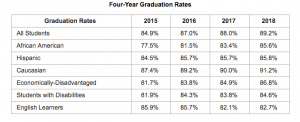Arkansas’ four-year graduation rates increase for third year
by April 9, 2019 2:58 pm 707 views

The state Department of Education said that four-year graduation rates for all Arkansas high school students and multiple student subgroups increased in 2018, continuing a three-year trend of positive improvement.
Graduation rate data for 2018, which will be released April 15 on the school, district, and state Report Cards, show that rates for all students, as well as African-American, Caucasian, and economically-disadvantaged students, increased for the third year in a row.
The four-year graduation rate for Hispanic students held steady or increased every year since 2015, with 2018 increases noted for students with disabilities (84.6%) and English learners (82.7%).
Graduation rates reflect kindergarten through the twelfth grade progression.
“This is one of the most satisfying educational statistics that we’ve received in recent years,” Gov. Asa Hutchinson said. “The fact that our graduation rate continues to improve in Arkansas shows that we are on the right path in terms of education in all categories, from minority students to economically-disadvantaged students. I applaud our educators in Arkansas for their dedication as we continue on this path to even greater achievement.”
“The continued increase in Arkansas’ graduation rate is encouraging and worthy of celebration,” Arkansas Department of Education Commissioner Johnny Key said. “As we seek to lead the nation in student-focused education, it is essential that we provide the tools, resources, and opportunities for every student to graduate high school prepared for college, career, and community engagement. ADE is committed to providing the supports every school needs to ensure we accomplish this mission.”
For the first time ever, graduation rates for additional student subgroups will be reported on the 2018 Report Card. The Report Card, which will be available on the My School Info website.
on April 15, will include graduation rates for homeless students, children in foster care, children with parents on active military duty, gifted and talented students, females, males, and migrant students.
Results for the last four years can be viewed below.

